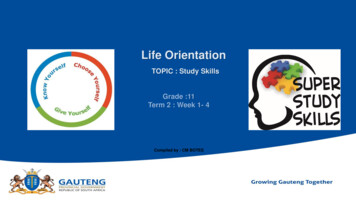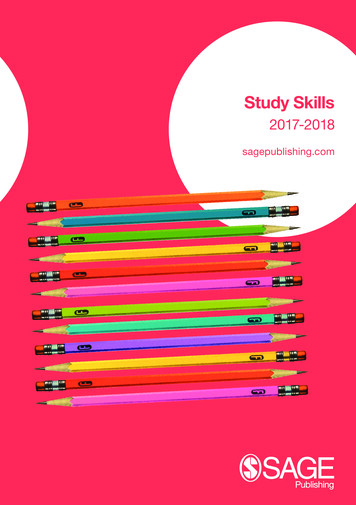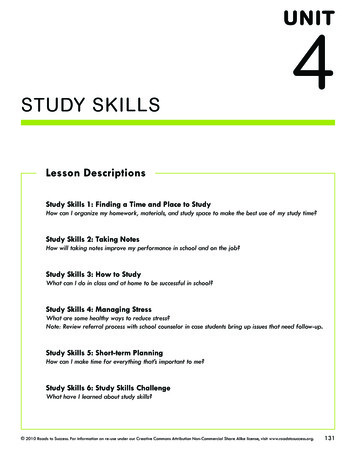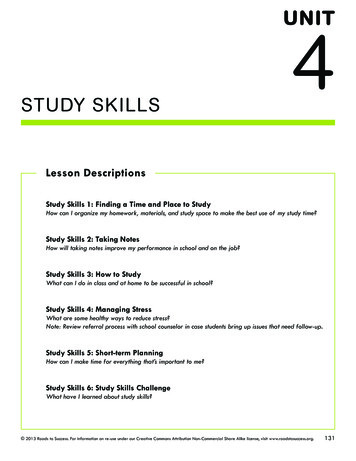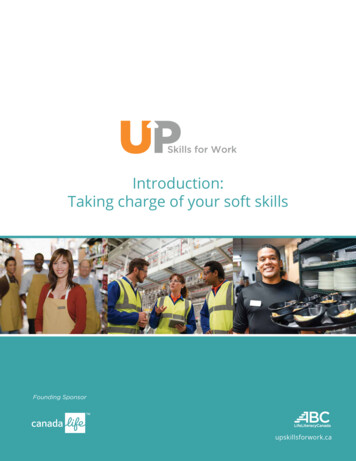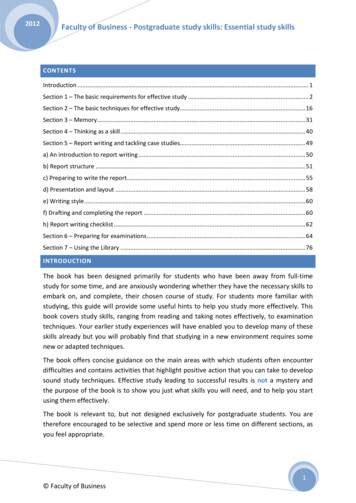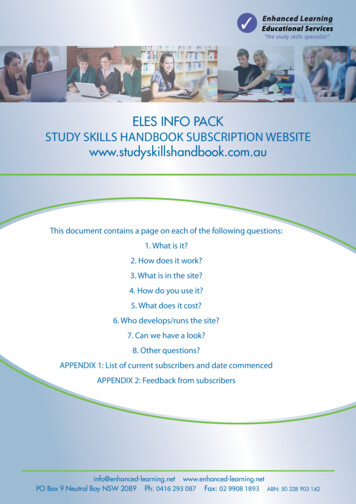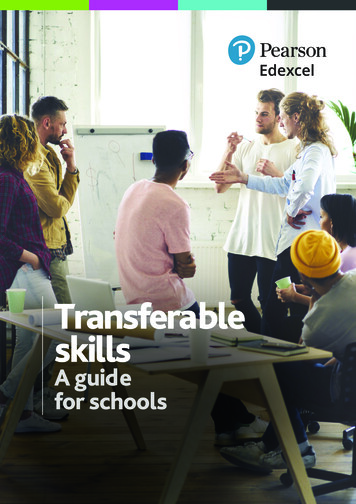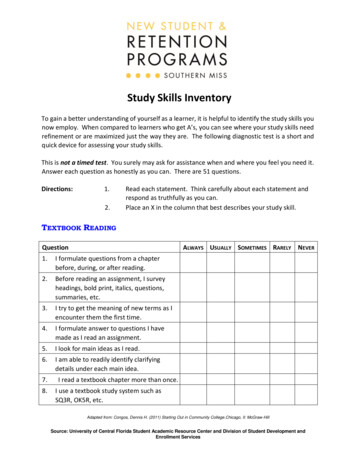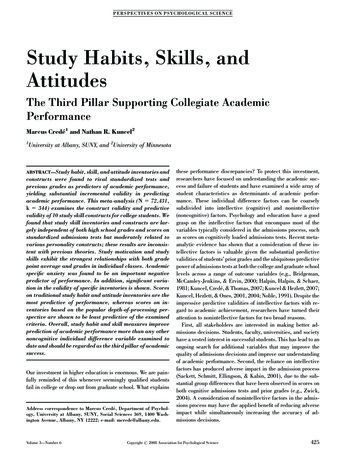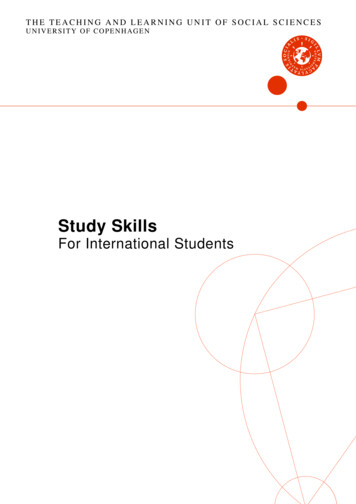
Transcription
THE TEACHING AND LEARNING UNIT OF SOCIAL SCIENCESUNIVERSITY OF COPENHAGENStudy SkillsFor International Students
Study Skills for International Studentswritten byThomas Harboe &Rikke von MüllenThe Teaching and Learning Unit of Social SciencesPublished 2007This guide is distributed free of charge to students and lecturers atthe Faculty of Social Sciences, the University of Copenhagen.The guide may be copied freely as long as the source of thematerial is explicitly indicated, and the guide is not used forcommercial purposes.
DEAR STUDENT4ASSESS YOUR STUDY CONDITIONS51: MOTIVATION AND CONCENTRATION7CONCENTRATE ON WHAT YOU ARE DOINGFIND OUT WHERE YOU WORK MOST EFFICIENTLY882: PLANNING10BEGIN EVERY SEMESTER BY PREPARING A STUDY PLANPLANNING REQUIRES OVERVIEWBREAK YOUR TASKS DOWN INTO SMALLER PARTSEXCERPT OF STUDY CALENDARPLAN YOUR BREAKS FROM THE STUDIES AS WELL10111214153: ACTIVE PARTICIPATION IN TEACHING16LEARN TO SPEAK UP AT THE RIGHT TIMETHE ROLE OF THE DANISH UNIVERSITY LECTURER16184: READING TECHNIQUE19BEFORE YOU READ THE BOOKENTERING THE READING PROCESSSELECT READING TECHNIQUE ACCORDING TO THE PURPOSE OF2022READINGDIVIDE THE READING INTO PHASES24265: NOTE-TAKING TECHNIQUE27CLASS NOTES272
READING NOTESMIND MAPSBE IN CONTROL OF YOUR NOTESUSE YOUR NOTES AGAIN AND AGAIN293133336: REQUIREMENTS FOR ESSAYS AND RESEARCH PAPERS34EXAM CHEATINGSOURCE REFERENCINGQUOTATIONSTHE USE OF FOOTNOTESTHE USE OF APPENDIXESREAD SAMPLE PAPERS3535373839397: WRITING TECHNIQUE40WRITE BEFORE YOU READSPEED-WRITINGWRITE ON A DAILY BASIS DURING YOUR STUDIES4040428: STUDY GROUPS43NIP UNPRODUCTIVE CONFLICTS IN THE BUDACADEMIC DISAGREEMENT IN THE GROUP IS PRODUCTIVE45479: HERE YOU MAY TURN FOR HELP4810 PIECES OF GOOD ADVICE FOR INTERNATIONALSTUDENTS49ADDITIONAL REFERENCES513
Dear StudentWelcome to the University of Copenhagen.This guide is aimed at international students who are studying inDenmark for the first time.Worldwide students are facing many of the same challenges. Theymust plan and structure their study. They are expected to studyefficiently and take useful notes. And they are expected to make themost of teaching, group work and supervision.International students who are placed in a foreign culture arechallenged even more. Besides all the formal issues with which theyare expected to be able to cope, they are forced to adjust rapidly toteaching methods, expectations and criteria which might differ fromthe ones at home.We wish to present our best advice on how to efficiently manage yourstudies at the University of Copenhagen, and at the same time, we tryto pass on our experiences with issues and situations which may seemforeign to international students.Especially the fact that there are only few lectures and individualsyllabuses places a huge responsibility on students at the University ofCopenhagen in terms of self-learning.Furthermore, many international students experience uncertaintyconcerning referencing, ownership and plagiarism because it isdifficult to figure out formal rules, or they obtain unusually bad gradesfor their papers because the evaluation criteria are not always explicit.We are of course unable to deal with and solve all problems related tostudy skills in this guide. In the bibliography at the back, suggestionsfor further reading material are found.We wish you all the best of luck with your studies at the University ofCopenhagenThe Educational Centre of Social Sciences4
Assess your study conditionsBefore you read on in this guide, please do the following exercisewhich will offer you an insight into your present study conditions. Theaim of the exercise is to show you where/ how to intervene, if youwant to improve your learning conditions. Repeat the exercise after acouple of months. Then you will be able to see whether you havesucceeded in improving your study conditions.Circle a number between 1 and 5FalsePartlyfalseNeithertrue norfalseTrueVerytrueAttitude towards learningI believe in my own capability12345I participate actively in classes12345I pose questions during classes when there issomething that I do not understand12345My goals and ambitions are realistic12345I find my studies interesting12345I am not suffering from stress as a result of mystudy tasks12345I enjoy concentrating on academic material12345I am good at study planning12345I am good at observing my study plans12345I always embark on new tasks as early aspossible12345I am good at dividing large tasks into smallerpieces which are easier to cope with.12345I study when I am rested12345I am good at taking breaks when needed12345I am good at avoiding interruptions12345I am good at concentrating12345I get work done when I study12345Learning efficiency5
My experience with group work is positive12345I think that it is important to work with otherstudents12345I do not suffer from writer’s block12345I write – often and a lot12345I take useful notes during classes12345I am good at highlighting central points in mysources – neither too much nor too little12345I take useful notes when I study12345I always try to get a general idea of a textbefore I read it in detail12345I am good at adjusting my reading technique tothe purpose of my reading12345I am good at separating the relevant from theirrelevant when I study123456
1: Motivation and ConcentrationMotivation, determination and self-discipline are indispensable toolsand core premises for completing a university programme.Especially self-discipline is a key to every study technique. Whenstudying at the University, you are in charge of your own course ofstudy. No one makes sure that you study sufficiently, whether youattend classes or whether you submit your essays or assignments. It isyour own responsibility to learn something, and it is a heavyresponsibility to face alone. Danish students too struggle to keep up tothe mark and to figure out the most efficient method of study.At the University of Copenhagen, regular tests are generally notcarried out as compulsory parts of a course. The extent of yourknowledge is only examined at the final exam. Therefore, it isextraordinarily important for students to keep themselves studying inthe course of the semester.As a consequence, it is very important to maintain the initial interestin the subject. Even if you grow tired of the text with which you arecurrently struggling, try to remember that it is a means to an end.However, studying has more to it than just self-discipline andmotivation. It is also important to do things the right way. Oftenstudents do not lack motivation, but more often lack knowledge andexperience when it comes to organising their studies properly. Forexample, a strong self-discipline is not worth much if you forget torevise your knowledge and consequently forget half of the syllabusbefore your exam. Neither does it do any good to study your booksfaithfully, if you forget to focus, analyse and reflect.7
Concentrate on what you are doingFirst and foremost, concentration is about avoiding thinking aboutother things when you study.Three good pieces of advice to increase concentration are: always read and write with a question and a purpose; take notes while you read; and vary your tasks during the day.Furthermore, concentration is about keeping noise and unnecessaryinterruptions at a minimum. In this respect, the important thing is toidentify and avoid disturbing elements in your surroundings –especially when you are in the process of writing a research paper orstudying for an exam.If you are sitting at your pc, do not open the web browser or mailbox.To most people, it is also a bad idea to have the television turned onwhile they study. All in all, phones, the television, the Internet,magazines, etc. are all potential time-wasting and disturbing elements.Concentration may fail for many reasons. Noise from the television inthe background is a direct and easily identifiable source of failure toconcentrate. However, more indirect and hidden sources are alsopresent. Maybe your teacher’s illustrations annoy you. Or perhaps youare worried about financial problems. Whatever the source, it isimportant that you offer yourself the best conditions to be able toconcentrate. Consequently, figure out what works for you and stick toit.Find out where you work most efficientlyIf you are easily distracted, try to establish a fixed work place at alocation without disturbing elements where you are outside the reachof the good intentions of your friends, where you are able to have all8
your study materials to yourself, and where you may come and go asyou please.Maybe this location is not your room. Maybe such a location does notexist. However, the departments’ libraries have a limited amount ofwork stations for students. The libraries may not be the best solutionfor you. However, in lack of a better location, they may prove useful.The Royal Library has some reading rooms in its departments locatedat Fiolstræde, Njalsgade and in “The Black Diamond” at Slotsholmen.However, it can be a problem that these libraries close at 19.00.Please contact the Student Counsellor’s Office at your department forinformation about additional locations where you may study in peace.9
2: PlanningPlanning is the key to study skills.A well-organised study plan offers you an overview of your tasks andmakes it possible for you to spread your tasks across the semester andprepare early for everything; thus ensuring that you are notoverwhelmed by unwritten essays and unread texts at the end of thesemester.The trick is to prepare a study plan which offers you a long-termoverview while giving you a short-term detailed time table of yourtasks here and now. The important thing is to divide and prioritiseyour daily tasks, thus ensuring that there is enough time for all of them– both your study related tasks and your other chores.Begin every semester by preparing a study planIt takes time to make an efficient study plan. However, the time youspend on planning is quickly made up for by the prioritisation anddetermination you achieve in your performance.Seek advice about which and how many subjects you should sign upfor. Perhaps you are used to attending 5-6 subjects in the course of asemester. However, students at Danish universities generally onlyattend 3 courses each semester. A subject may very well bedemanding and strenuous even though it does not have that manyweekly lectures, and experience shows that many internationalstudents underestimate how much independent studying a subjectrequires. The Student Counsellor’s Offices of the departments are ableto help you get an overview of the subjects’ levels and workloads.10
Begin your planning in the following manner: take a comprehensive view of your expected tasks; take a comprehensive view of your engagements and activitiesoutside your studies; prioritise the tasks to separate the very important tasks from theless important tasks; set deadlines for the various tasks and parts of tasks; and establish fixed working hours.Remember that goals, work schedules and deadlines must be realistic!It is always a good idea to embark on tasks early. When you startworking on a task, you will discover that your subconsciousness startsto work for you.Planning requires overviewIn order to be able to prepare an efficient study plan, you have to takea general view of your syllabus, your subjects in the course of thesemester and your additional activities.On a general level, you are able to read about the types and aims ofthe individual courses in the curriculum or the course description ofwhich the most recently updated versions are always available on theInternet.For every course, the lecturer prepares a course plan. It states thespecific focus area of the individual lectures and moreover, thematerial which you are expected to read and prepare for eachindividual class. This course plan is usually handed out during the firstlecture or is available on the homepage of the course.11
In the course plan you are able to see how your lecturer prioritises thesubjects of the course. Which subjects are connected? Which subjectsare given more attention than others? Most lecturers give anintroduction to the course in the first lecture of the semester.Furthermore, you are given a list of the syllabus and a bibliographywhich enables you to see the subjects you will cover as part of thecourse. The syllabus is the material you must read. Often thebibliography indicates secondary reading material within the scope ofthe subject.In other words, on the basis of the syllabus list, you are able to figureout the number of pages you must read each day in order to have readthe entire syllabus before the exam. However, this only serves as aguideline, and when you study a subject it is never enough just to readall pages of the literature (please see the chapter about readingtechnique).A general assessment makes it easier to prepare a useful study plan.Begin by assessing the long-term plans, establishing a generalimpression of the semester ahead of you. Fasten this plan to yournotice board or your refrigerator where it may act as a generaloverview of your study activities during the semester.Break your tasks down into smaller partsAfter preparing the long-term study plan for the semester, theindividual tasks may be broken down into smaller parts. In that way,you only have to focus on one small part at a time, while still beingable to maintain the broader perspective! The point is that you shouldcome to view your course of study as a process of which every partcontributes to your academic development.12
For every part, you must establish a detailed short-term study plan andkeep this plan up-to-date on a running basis as regards actual plans forreading and writing in the course of the coming weeks and days.Below you are presented with two excerpts of planning schedules ofone semester’s tasks. Next to this kind of plan, you may prepare amore detailed week plan on which you record your tasks here andnow. However, less might suffice, and the essential thing is that youare able to see the broader perspective.Excerpt of study planExtraordinary study tasks in the springDeadlineFebruaryWritten exercise subject 35 MarchMarchGroup presentation subject 1 24 MarchAprilWriting exercise subject 330 AprilMayIndividual presentationsubject 26 MayScreening examinationsubject 112 MayExam subject 23 JuneExam subject 118 JuneJune13
Excerpt of study unMon. Subject 1Subject 3Tue. Subject 2StudyWeds. Study at the libraryThurs. Study group Subject 3Fri. Study at the librarySat.Study at9 Sun.home10 Mon. Subject 1Subject 311 Tue. Subject 2Study12 Weds. Study at the library13 Thurs. Study group Subject 314 Fri. Victor’s birthday15 Sat. WorkApril 12345615 789 Weds. Study and write1616 Sun.121317 Mon. Subject 118 Tue. Subject 2Subject 3StudyMeetingconc.19 Weds. Studypresentation20 Thurs. Study group Subject 321 Fri. Prepare presentation1722 Sat.MeetingStudy atconc.23 Sun.homepresentationPresentation24 Mon.Subject 3Subject 125 Tue. Subject 214Study26 Weds. Study at the library27 Thurs. Study group Subject 328 Fri. Study at the library29 Sat. Work30 Sun.31 Mon. Subject 1Subject 3MorningAfternoonTue. Subject 2StudyWeds. StudyExcursionThurs. Study group Subject 3Fri. Begin writ. exerciseSat.Sun.WriteMon. Search for literatureTue. Study and write10 Thurs. Study and write11 Fri. Summer house12 Sat.13 Sun. Easter party14 Mon.Study15 Tue. Subject 2StudyWriting16 Weds.Writegroup17 Thurs. Study group Subject 318 Fri. Study at the library19 Sat.20 Sun.21 Mon. Subject 122 Tue. Subject 2WriteSubject 3Study23 Weds. WriteStudy24 Thurs. Study group Subject 3Writinggroup26 Sat. Work27 Sun. Revise18 28 Mon. Subject 129 Tue. Subject 230 Weds. SubmitMay 1 Thurs. Study group25 Fri. No studying14ReviseSubject 3Print, etc.StudySubject 3
Plan your breaks from the studies as wellSometimes international students travel and in these cases it isimportant to plan the return to the course of study very carefully.Before you leave, it is wise to: tidy your work table make an appraisal of how far you have come in your studies; and write a list of the tasks which you must work on immediatelyupon return.In this way you avoid having to spend several days re-establishingyour course of study after the break. Furthermore, you are able toenjoy your break more, as you are on top of the planning of the courseof study.15
3: Active Participation in TeachingTraditionally, the basis of Danish teaching is the active student, andstudents are expected to pose questions if there is something whichthey do not understand. In that respect, Danish students are trained totake responsibility for their own education.This tradition is based on the assumption that students learn very littleby passive participation in the lectures, i.e. just by listening. Studentsneed to work with the material for themselves, need to havediscussions, analyse, calculate and use the academic material in orderto memorise it and be able put it into use outside the classroom.It is also important to ask questions; not only when you are missing afactual piece in your knowledge puzzle, but also on a more abstractlevel. No theorist is such an authority that it is useless to questionwhether his theories may be flawed, or if it is possible to furthersubstantiate or concretise the theory. It is a core constituent of anacademic programme that the accepted truths of a subject arecontinuously tested.This type of critical analysis is rewarded in the Danish educationalsystem. Often the highest grades are awarded to the most independentperformances, and this is just one more reason for practicing this typeof independent analysis and discussion during classes, wheneveropportunity presents itself.Learn to speak up at the right timeIn other words, it is important not to be afraid of speaking up in class.Of course, you should only take the floor if you have relevantcontributions to the discussion. The trick is to be active in anacademic and constructive way.16
There are several ways to actively participate in classes: short student presentations which have been prepared at home; discussion groups focusing on a specific topic or question; plenary discussions where the lecturer chairs the meeting; elaborate questioning of the syllabus or illustrations; discussion forum on the homepage of the course; and/or taking notes.If you are not ready for this, it may be rewarding to take some time tolearn how to prepare a productive introduction to a debate. As astarting point, listen to the other students, how they formulate theirquestions and put them forward in the classroom. However, try tomake yourself heard in class at a relatively early stage (the sooner youvoice yourself, the more natural it will be to yourself and the rest ofthe students that you make yourself heard). For example, try toprepare a short presentation with a single clearly stated point that youwish for the class to discuss or the lecturer to comment on.Of course the fact that the courses are not necessarily taught in yournative language does not make it easier for you to participate in thediscussions during class. However, English is not the native languageof the Danish students either, and the lecturers as well as your fellowstudents are usually very tolerant towards less than perfectformulations. The important thing is that you take the chance toformulate your questions and thoughts, which allows you to practiceputting the material into use and reflect on it actively.17
The role of the Danish university lecturerDanish teaching traditions also bid that the university lecturer is veryflexible, and this means that several lecturers are of the opinion thattheir role as teachers is to act as supervisor and discussion partnerrather than as an academic lecturer.Most tenured lecturers at the University are scholars who have otherduties besides teaching. Consequently, your lecturers possess anacademic knowledge and insight from which you may benefit.However, even though the lecturers possess an academic expertise,they are not to be perceived as authorities who should not becontradicted in an academic and constructive way.During class, this if often reflected in the fact that the lecturers expectdiscussions and active participation from the students.It is true that to a high degree, conventional lectures for large groupsof students are still found at the University. But the lectures are oftensupplemented by classes with fewer participants where groupexercises, student presentations and plenary discussions take place.This way, the teaching becomes more fun and educational for thestudents as well as the lecturer.18
4: Reading TechniqueThere is a lot of reading to be done on all university programmes.Furthermore, several Danish study programmes are characterised by alimited amount of lectures and a comprehensive independent studyprogramme. This means that the University’s students study more orless independently. Since rote learning is not very applicable to mostprogrammes either, it is not enough just to read a large quantity ofmaterial thoroughly or a sufficient number of times. The importantthing is that the students themselves are capable of actively processingthe material, whether independently or in groups.Nevertheless, students tend to focus on the amount of material whichhave been read or more accurately, on the amount of unread materialwhich accumulates on the desk and is the cause of a guilty conscience.The large amount of unread material may of course be caused by thefact that a student is lazy, unmotivated or preoccupied with othermatters. Or that the syllabuses are too ambitious and impossible to getthrough. And naturally, studying is made all the more difficult whenthe material is not written in the student’s native language.Many students think that they are slow readers. However, experiencehas shown that it is rarely “the number of lines read per minute”which causes problems.First and foremost, the problem is that students read in the wrong way.For example, many students tend to commence their studies byreading page 1 of the first book in the syllabus without establishingwhat and why they are reading. Instinctively, they read the bookslinearly from beginning to end. The disadvantage of this readingmethod is that the continuity of what is read is lost.This chapter outlines a useful study strategy - a strategy which youmay apply regardless of the type of book that you are reading. It isimportant that you are aware of how you go about a study book from19
the first time that you hold it in your hands till you if necessary readthe book thoroughly.Before you read the bookIt is possible to read a text several times without understanding any ofthe content or its purpose. If you do not think about and reflect on thematerial you are reading, you will not learn anything. Consequently,you should start by posing two questions: what type of text is this?What is the aim of the text?Question 1: what type of text is this?In order to be prepared for the new text, it is a good idea to drawparallels to other texts you have read. Take the time to make anassessment of the structure of the syllabus texts. How are they usuallystructured? Which elements are typically included in the texts? It isimportant that you become aware of the different types of material(genres) you are reading, and are aware that the structure and contentof the different genres differ to a great extent. This is best illustratedby two very different types of material you will inevitably comeacross in the course of your programme:Textbooks: Some of the books you will come across at the Universitylook a lot like ordinary school books, the purpose of which is toconvey knowledge and teach. Textbooks very rarely discuss anything,and it is therefore important that you remain critical of the content.The chapters in textbooks are typically not written to be read in aprescribed order, but rather subject by subject as is the case inencyclopaedias. Consequently, you may read the individual chaptersin random order and still appreciate the overall meaning.Research reports: Research reports have an altogether differentpurpose than textbooks. In these, analyses, discussions and theevaluation of the research results count. The object is not to conveyknowledge or explain scientific terms. Therefore reports are20
sometimes difficult to read. Nevertheless, these texts are made up ofrelatively obligatory elements, you may use as guidance (some arementioned on the next page). Moreover, the structure of researchreports is usually less flexible than the equivalent in textbooks.Chapters often follow a continuing argumentation, which makes itdifficult to read the chapters in random order.As seen above, the different types of text you come across in thecourse of your study differ to a large degree, which makes it necessaryfor you to read them in different ways.Question 2: What is the aim of the text?It is of course difficult to establish one book’s actual relevance to youand your studies in advance. You have to crawl before you learn towalk, and it is not unusual that the underlying relevance of a bookbecomes apparent a long time after you have finished reading it. Butremember that, academically speaking, you never start from scratch.You always possess relevant knowledge and references which youmay use to assess new texts. You have already obtained relevantknowledge through previous studies and school attendance, television,newspapers, etc.You should insist on placing yourself in the centre of things. Thebooks are made for your benefit – not the other way around. In otherwords, do not allow yourself to be controlled or impressed by thebooks and their authors. You must dare to prioritise and decide whichsubjects are important to you, e.g. a subject you are having troubleunderstanding.Naturally, an exam or a specific written assignment makes it easy toestablish the relevance of individual texts. If the text forms part of thesyllabus, it is usually relevant to you no matter what you might thinkof it otherwise. However, it is rare that all texts form part of a researchpaper or exam in the exact same way or at the exact same level, andconsequently, you have to carefully consider which type of problem21
you are about to solve. Does the text offer key information about thesubject? Or is only secondary information offered?Entering the reading processIt is always a good idea to begin the reading by familiarising yourselfwith the text. If you read slavishly from page 1 and onward, you risklosing the broader perspective. Furthermore, it is not uncommon tolose concentration if a text is read linearly from a to z, because thenthe text and not you yourself is in charge of your studies.Every time you receive a new syllabus book of 200-300 pages, it is agood idea to earmark as much as one hour to familiarise yourself withit. This is the best way to really get an overview of the content of thebook and its core subjects before you decide how to read it.Four efficient ways of familiarising yourself with a new text are:Read those parts which offer the most comprehensive view of the textMost texts have a number of “keys” which may be used to identify thestructure of the text as well as its core points. Well-written textscontain most of the keys below which make it possible to quickly getan idea of the text. Other texts are less informative in terms of aidingthe reader in getting a quick overview. Title Entrys in the margin List of content Words in bold Headings Textboxes Subordinate headings Figures, graphs, models Preface Abstracts in the text Text on the back of the book Index Illustrations Index of names22
Read the beginning and end of each chapterMany textbooks use space to guide the reader around the book. Often,every new chapter starts by offering the reader an overview of thecentral points of the chapter as well as the chapter’s connection to theother chapters. Likewise, there are textbooks which sum up the centralpoints at the end of each chapter.Read the introduction and the conclusionAs for research reports, the introduction and the conclusion offer acomprehensive overview of the text. The introduction will reveal thefocus area of the text and its positioning in relation to other academictexts. The conclusion offers a short summary of the key questions ofthe text and tries to answer these on the basis of the analyses whichhave been carried out.Write, draw or discuss your way to a preliminary overviewGenerally, it is advisable to never just read a text - remember also towork with the texts read. This also applies to the initial reading phaseduring which you combine the overview reading with other activitieswhich allows you to see the broader perspective. Below are fourproposals for the above: Draw a mind-map (c.f. chapter 5) of your initial impression ofconnections and points in the book. Write a short piece on your first impression of the book. Ask your fellow students what they think are the central points ofthe book. Ask your lecturer what the overall themes of the book are, andwhich chapters are connected.23
Select reading technique according to the purpose of readingEven when you have applied above techniques to create an initialoverview of the text and have decided that you wish to read the text,there are different ways of reading it. You would never read a crimenovel in the way that you read a syllabus book. You read the crimenovel for the sake of entertainment and suspence and you do not needto remember the details. However, syllabus books are read becausethey contain important information which form part of your long-termstudy process. Consequently, the purpose of reading is an altogetherdifferent one in this case. Your choice of reading technique depends
reading notes 29 mind maps 31 be in control of your notes 33 use your notes again and again 33 6: requirements for essays and research papers 34 exam cheating 35 source referencing 35 quotations 37 the use of footnotes 38 the use of appendixes 39 read sample papers 39 7: writing technique 40 write before you read 40 speed-writing 40 write on a daily basis during your studies 42
